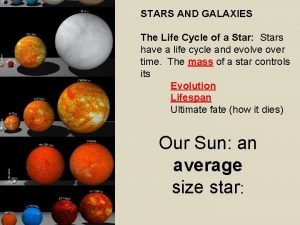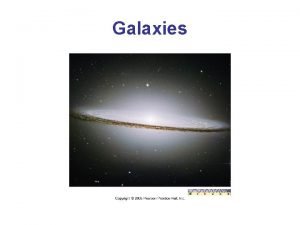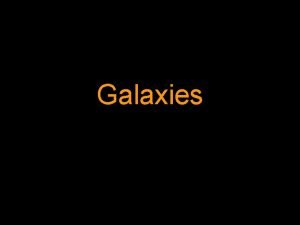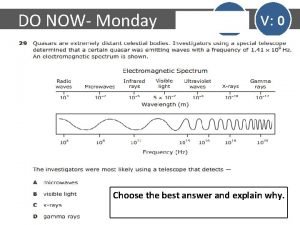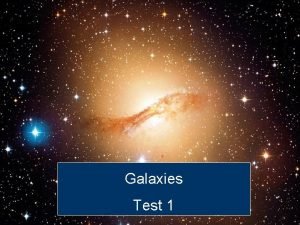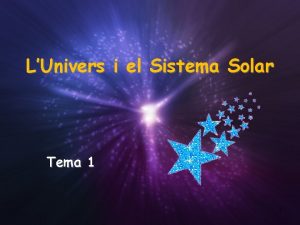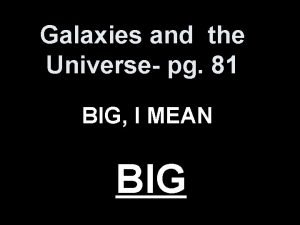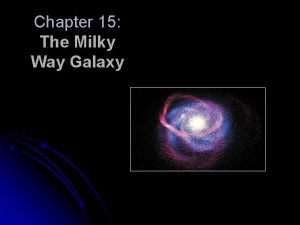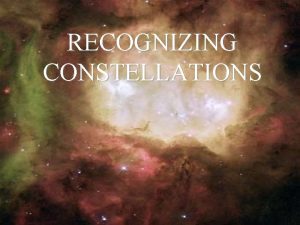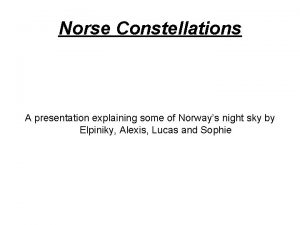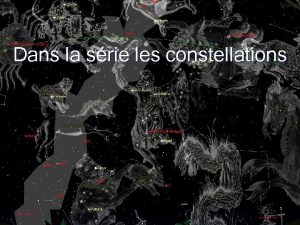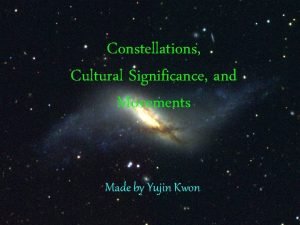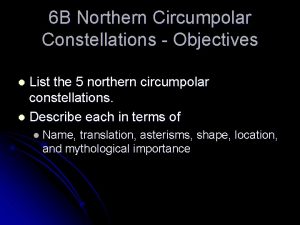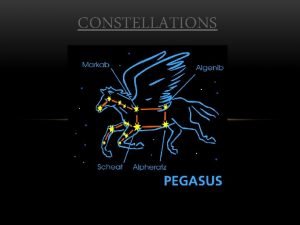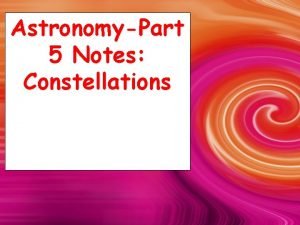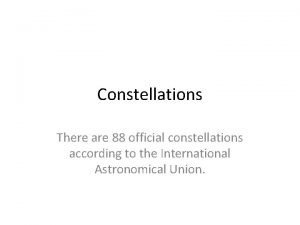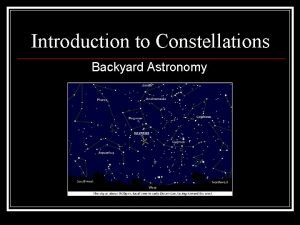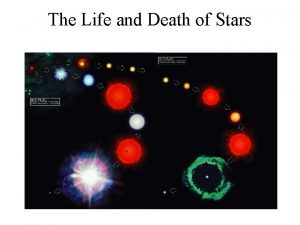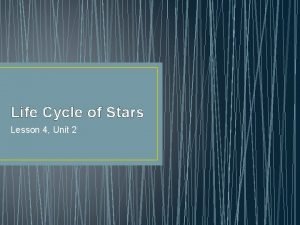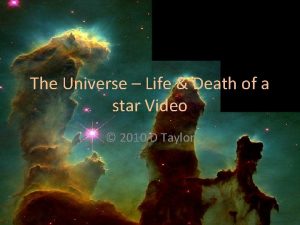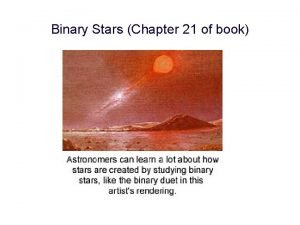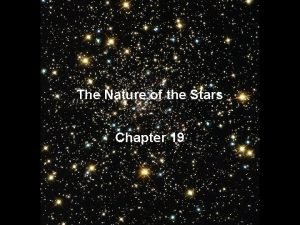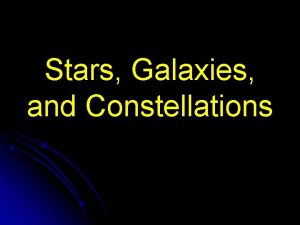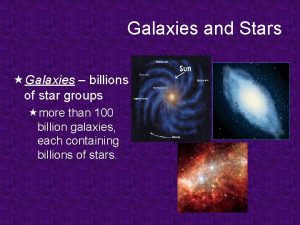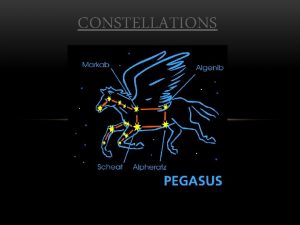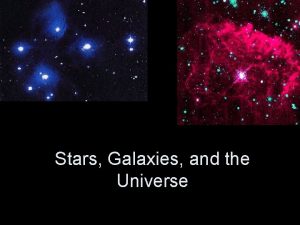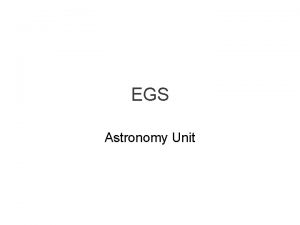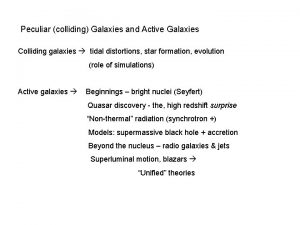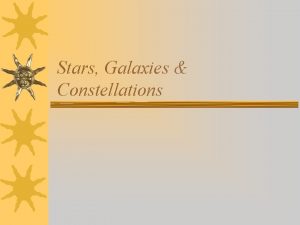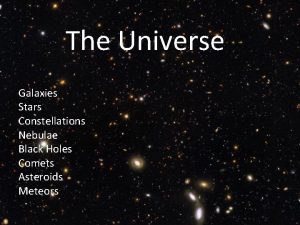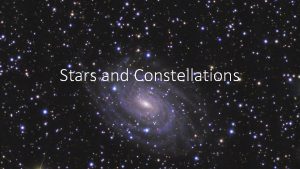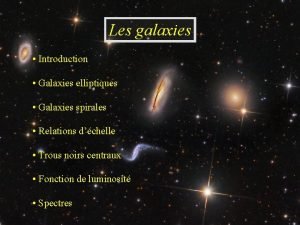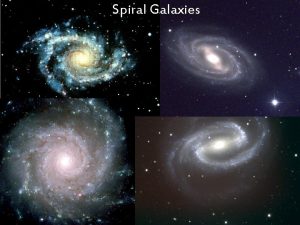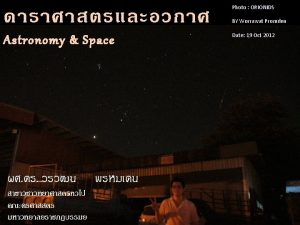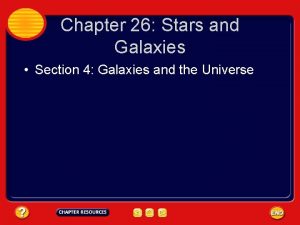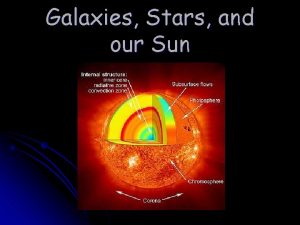Stars and Galaxies Constellations Constellations Certain groups of































































- Slides: 63

Stars and Galaxies

Constellations • Constellations- Certain groups of stars named after animals, characters in mythology, or familiar objects – From earth constellations look like groups of stars close together – Brightest star in the winter sky is Sirius – 88 constellations – Star Polaris – North Star



– Appear to move because earth is moving – Stars also appear to change position in the sky throughout the year • Earth revolves around the sun • As earth orbits different constellations come into view while other disappear • Appendix j pg 674 -675


Absolute and Apparent Magnitudes • Absolute Magnitude – Is a measure of the amount of light is actually given off • Apparent Magnitude – Amount of light received on earth • Example: Sirius – 100 x closer to earth then Rigel, therefore appears brighter

Determining distances • Parallax – Apparent shift in the position of an object when viewed from two different positions – The nearer an object is to the observer, the greater its parallax – Distance in space are measures in light years • Light year is the distance light travels in 1 year • Light travels at 300, 000 km/s



• Nearest star other then the sun is Proxima Centuri – 4. 2 light years away – It takes 4. 2 years for light from that star to reach you • Stars temperature is determined by the color of the star




– Very hot stars – blue white color – Cool stars – orange or red – Stars temperature close to the sun – yellow


Evolution of Stars • H-R Diagram – Graph that shows relationship a stars temperature to its absolute magnitude – Most stars fit into the main sequence of stars • • Hot blue bright stars (upper left) Cool Red dim stars (lower right) Sun is a yellow medium temp. star 90% of all stars are Main Sequence



– The other 10% are Super Giants, White Dwarfs • Evolution of Stars – Stars begin as a large cloud of gas and dust called a nebula – At high temperature Fusion begins – Main sequence star forms – Begins to use its hydrogen

– When hydrogen fuel runs out, expands and becomes a giant – Core collapses – Outer portion of the giant blows away forming a white dwarf – Eventually the white dwarf uses its fuel and becomes a cold dead star – If a super giant (30 times our sun) collapses it may turn into a black hole




Black Hole





The Sun

The Sun • 99% of all matter in our solar system is the sun • It is the center • Makes life possible on earth • Just an average star • Enormous ball of gas, fusing hydrogen into helium at its core


• Layers of the suns atmosphere – Photosphere – • lowest layer from which light is given off • Temp. 6000* C – Chromosphere • Upward about 6000 Km – Corona • Largest layer, extend out millions of km in space • Temp. 2, 000*C • Charge particle escape causing solar wind

• Sunspots – Dark areas on the suns surface, which are cooler then their surroundings – Sun rotates • Rotates faster at its equator than at its poles • It takes 25 days for a sunspot to go around the sun at the equator



• Prominences and flares – Intense magnetic field associated with sunspots may cause prominence, huge arching columns of gases – So eruptive that material from the sun is blasted into space 1000 Km/sec




• Sun is a main sequence star • Most star are in a system in which two stars orbit each other (Binary system) • Our sun does not do this • Some stars move through space as star cluster


Galaxies

Galaxies • Large group of stars, gas, and dust held together by gravity • Galaxies are separated by huge distances, often millions of light years • Three types of galaxies – Elliptical – Spiral – Irregular

Types of Galaxies


• Elliptical is the most common – Vary in size – Football shaped • Cluster of galaxies that the Milky Galaxy belongs to is called Local Groups • Spiral Galaxies have spiral arms – Milky Way is a spiral Galaxy

• Irregular Galaxies – Many different shapes – Cloud of Magellan Orbit

Spiral

Irregular

Elliptical

Milky Way Galaxy • In our galaxy, all stars orbit a central region • 200 million years for the sun to orbit this central region • Contains more then 200 billion stars



Expansion of the Universe • When a Spectrograph is used to study light from galaxies beyond the Local group, there is a red shift in the light • Because there is a red shift in the light, all galaxies must be moving away from earth • Doppler Shift • Big Bang Theory states that between 15 and 20 billion years ago, the universe began expanding out of an enormous explosion




• There is evidence that supports the Big Bang Theory – Scientist have discovered radiation in space that they believe was created by the explosion • All matter exerts a gravitational force • If there is enough matter, gravity will halt expansion • A big crunch would result

Meteors • A meteoroid is matter revolving around the sun or any object in interplanetary space that is too small to be called an asteroid or a comet • A meteorite is a meteoroid that reaches the surface of the Earth without being completely vaporized • term meteor describe the streak of light produced as matter in the solar system falls into Earth's atmosphere creating temporary incandescence resulting from atmospheric friction.



 Electromagnetic star
Electromagnetic star There are three sizes of schnauzer dog
There are three sizes of schnauzer dog Chapter 30 galaxies and the universe
Chapter 30 galaxies and the universe Galaxie s
Galaxie s How are ethnic groups and religious groups related
How are ethnic groups and religious groups related Life cycle of a galaxy
Life cycle of a galaxy Elliptical galaxies facts
Elliptical galaxies facts Th eirregulars
Th eirregulars Era of galaxies
Era of galaxies Critical density
Critical density Types of galaxies
Types of galaxies Brainpop galaxies quiz answers
Brainpop galaxies quiz answers 4 types of galaxies
4 types of galaxies How are active galaxies classified?
How are active galaxies classified? Tipus de galaxies
Tipus de galaxies Properties of elliptical galaxies
Properties of elliptical galaxies Evolution of galaxies
Evolution of galaxies Universepg
Universepg Galaxies lesson plan
Galaxies lesson plan Year round constellations
Year round constellations Viking constellations
Viking constellations Les constellations les plus connues
Les constellations les plus connues Yujin constellations
Yujin constellations Cepheus horse
Cepheus horse Tumblr
Tumblr What are constellations
What are constellations Are constellations capitalized
Are constellations capitalized Constellations defintion
Constellations defintion Constellations
Constellations 88 official constellations
88 official constellations Are constellations capitalized
Are constellations capitalized Constellations defintion
Constellations defintion Five circumpolar constellations
Five circumpolar constellations A cart is pushed and undergoes a certain acceleration
A cart is pushed and undergoes a certain acceleration Certain and uncertain digits
Certain and uncertain digits Certain infectious and parasitic diseases
Certain infectious and parasitic diseases Two stars and a wish template
Two stars and a wish template Medium sized stars end their life as a
Medium sized stars end their life as a The life and death of stars
The life and death of stars Number the stars chapter 10
Number the stars chapter 10 Star with small and medium mass
Star with small and medium mass Coefficient of x
Coefficient of x H-r diagram worksheet doc
H-r diagram worksheet doc Two stars and a wish template
Two stars and a wish template Where does joshua barnes think they come from
Where does joshua barnes think they come from Plough stars summary
Plough stars summary Watching and seeing shooting stars on a dark night
Watching and seeing shooting stars on a dark night Why do disk stars bob up and down as they orbit the galaxy?
Why do disk stars bob up and down as they orbit the galaxy? The plough and the stars characters
The plough and the stars characters Stars dogs plowhorses and puzzles
Stars dogs plowhorses and puzzles Binary star book
Binary star book Number the stars vocabulary and questions answer key
Number the stars vocabulary and questions answer key What is your favorite tv show give 3 reasons why
What is your favorite tv show give 3 reasons why The stars and i chapter 19
The stars and i chapter 19 Certain things hang on forever
Certain things hang on forever Emily dickinson poem 258
Emily dickinson poem 258 Sonnet 39 sir philip sidney analysis
Sonnet 39 sir philip sidney analysis Queuing theory and waiting line model
Queuing theory and waiting line model An informed guess or assumption about a certain problem
An informed guess or assumption about a certain problem Certainty factor
Certainty factor Type of cell
Type of cell A certain light bulb
A certain light bulb There once lived a man in russia
There once lived a man in russia Path of a moving point
Path of a moving point





